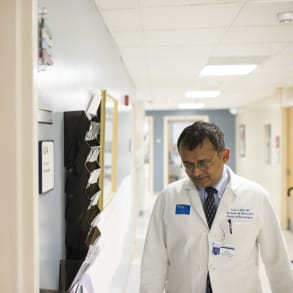Dr. Sunil Patel, Chief of Neurosurgery at the Medical University of South Carolina, discusses a rare case of Bobble-Head Doll Syndrome. Characterized by a "yes-yes" head bob, the syndrome is often associated with cystic abnormalities in the third ventricle that produce hydrocephalus. Opting against the traditional craniotomy, Dr. Patel drained the cyst endoscopically—a 15-minute procedure requiring an incision only an inch long. MUSC specializes in minimally invasive endoscopic neurosurgery.
SUNIL J. PATEL: So the bobble-head syndrome is an interesting syndrome. It's a very unique symptom related to a very special area of the brain. Very few children are diagnosed with that. 30 years of practice, this is the first case I saw. Mickey came to us with a progressive bobbing of his head. So on the MRI scan that was ordered, there was a very large cyst that he had in a very deep location in the brain, in the area we call the third ventricle. And the cyst was-- in itself the cyst is benign because it has only spinal fluid, but the cyst was so large that it had obstructed the fluid draining from the brain, so he also had hydrocephalus because of that. So the main treatment ought to be draining the fluid out, and that's the other specialty thing we have. We have ways of doing very minimally invasive surgery here with endoscope. Able to, in his case, for example, we were able to go in there and drain the cyst, and remove some of the capsule of the cyst, which is just arachnoid, so that it decompresses the brain. The general outcome from this is very good actually, now that we don't have to do craniotomies to treat lesions like this and just use an endoscope. First of all, the incision for an endoscope is less than half an inch, and so they heal very quickly from that incision. The surgical time is very short also. In his case, we probably took about 12, 15 minutes to do the surgery. I think one of the good things we have here is a dedicated Children's Hospital. We admit children with all kinds of unusual disorders, from cardiac to brain and things like that. And one of the things I enjoy when I treat children here with problems is that the nursing and the specialized nursing care that they have in the unit, and the infrastructure they have in the dedicated Children's Hospital for recovery of the children. The facilities they have for the parents, the social workers they have. Everything is dedicated to child care and all the things that go around it. You have a sick child, you also have very, very anxious parents. And many, many nursing staff and folks around in the Children's Hospital that help these families cope with what's going to happen to their child. We're going to be grateful for this patient. I think many of the students and residents that were here while he was being treated will have learned from that. But we hope to be able to keep this case on file so that others would look at this and learn from it, and catch the diagnosis early enough.





